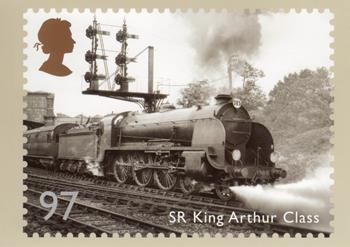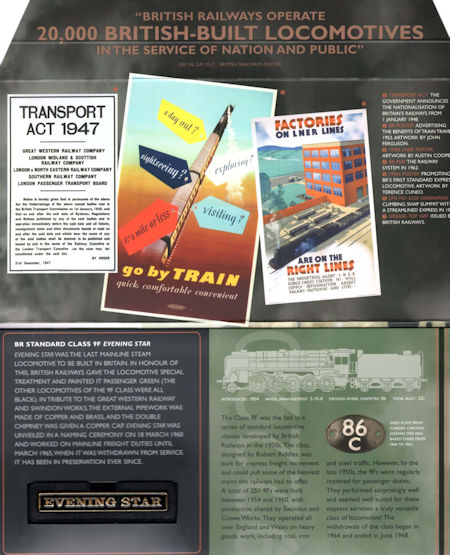Great British Railways
2010 (August 19 2010)Commemorative
Designed by Delaney Design Consultants
Size 41mm (h) x 30mm (v)
Printed by De La Rue Security Print
Print Process Gravure
Perforations 14.5 x 14
Phosphor All Over
Gum PVA
Great British Railways , Vol.47 No.10 (Issue Details)
Stamps
LMS Coronation Class
1st 2827
2827The streamlined Coronation Class locomotive Coronation of the London Midland and Scottish Railway at the platform in London’s Euston Station in 1938.
Introduced at the height of the 1930s’ streamlining craze and named in honour of the accession of King George VI, a Coronation was displayed at the 1939 New York World’s Fair. The streamlining was removed in the 1940s to save on maintenance.
 LMS Coronation Class at Wikipedia
LMS Coronation Class at Wikipedia
BR Class 9F Evening Star
1st 2828
2828Evening Star, the last of the British Rail Class 9F locomotive is shown here at Midsomer Norton in 1962.
The 9F was designed to pull heavy freight trains. But a few, like Evening Star, were used on passenger services, particularly on the steeply graded Somerset and Dorset line.
 BR Class 9F at Wikipedia
BR Class 9F at Wikipedia
GWR King Class
67p 2829
2829The photograph shows the Great Western Railway’s King Class locomotive – King William IV near Teignmouth in 1935.
The Kings were the GWR’s star locomotives, equally at home on heavy holiday trains and crack business expresses. Publicised as the UK’s most powerful express steam engine, the sleek lines of King George V wowed crowds when touring the USA in 1927.
 GWR King Class at Wikipedia
GWR King Class at Wikipedia
LNER Class A1
67p 2830
2830The stamp shows the London North East Region Class A1 locomotive, Royal Lancer photographed in 1929.
The LNER’s first standard design for long-distance expresses, the A1s included the Flying Scotsman, the first UK steam engine officially to reach 100mph. Modernised from the 1930s the class was still hauling important passenger trains in the early 1960s.
 LNER Class A1 at Wikipedia
LNER Class A1 at Wikipedia
LMS NCC Class WT
97p 2831
2831A London Midland and Scottish Northern Counties Committee Class WT – Engine No 2 shown here at Larne Harbour, circa 1947.
Based on a standard LMS design but built for the wider Irish track, the WTs were the last new steam locomotives delivered to the NCC. Widely known as ‘Jeeps’, they were a highly successful engine used on both passenger and goods trains.
 LMS NCC Class WT at Wikipedia
LMS NCC Class WT at Wikipedia
SR King Arthur Class
97p 2832
2832Named after a character from the legends of King Arthur the Southern Region King Arthur Class locomotive, Sir Mador de la Porte, was photographed at Bournemouth Central Station between 1935 and 1939.
The King Arthurs proved to be fine locomotives capable of handling the Southern’s heaviest express trains. Displaced by more modern engines from the 1940s, they hauled secondary services into the 1960s.
 SR King Arthur Class at Wikipedia
SR King Arthur Class at Wikipedia
Souvenir Pack
Cost : £24.95
Issued on September 7 209
RM Code PP001
Excellent presentation box containing high quality illustrations of the six engines from Augusts Great British Railways issuewith a special postmark. It also includes a booklet that describes each locomotive and stamp cards.
PHQ Cards































